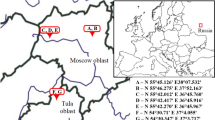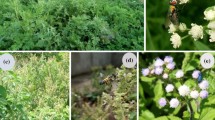Abstract
The movement patterns of flower-visiting Cetonia (Coleoptera, Scarabaeidae) were studied in central Sweden over 4 years, providing the first quantitative study of beetle pollination behaviour conducted in a temperate zone. The beetles were marked individually and tracked throughout their visits to Viburnum opulus L. (Caprifoliaceae), a partly beetle-pollinated shrub displaying large umbel-like, creamy-white blossoms. Beetle abundance differed greatly between study years. Of marked beetles observed on V. opulus flowers, an average of 26% returned each year. The beetles performed frequent inter-plant flights, and showed fidelity to particular V. opulus individuals at the study site. Furthermore, they preferred V. opulus to other plants flowering concomitantly and showed considerable constancy in this habit. Movements were mostly between individuals from unshaded locations with high inflorescence and flower number. Normally, the beetles flew on average about 4 times the horizontal nearest-neighbour distance between flowering V. opulus (c. 18 m). From these observations it is concluded that Cetonia beetles are powerful long-distance dispersal agents for V. opulus pollen, perhaps leading to an enhanced gene flow not possible with the plant's other pollinators.
Similar content being viewed by others
References
Antlfinger AE (1982) Genetic neighborhood structure of the salt marsh composite, Borrichia frutescens. J Hered 73: 128–132
Bawa KS (1983)_Patterns of flowering in tropical plants. In: Jones CE, Little RJ (eds) Handbook of experimental pollination biology. Van Nostrand Reinhold, New York, pp 394–410
Beattie AJ (1976) Plant dispersion, pollination and gene flow in Viola. Oecologia 25: 291–300
Faegri K, Van Der Pijl (1980) The principles of pollination biology, 3rd edn. Pergamon, London
Ferguson IK (1976) Viburnum L. In: Tutin TG et al. (eds), Flora Europea 4. Cambridge University Press, Cambridge, p 45
Fuchs G-V (1974) Die Gewinnung von Pollen und Nektar bei Käfern. Natur Mus 104: 45–54
Heinrich B (1976) The foraging specializations of individual bumble-bees. Ecol Monogr 46: 105–128
Heinrich B (1976) “Majoring” and “minoring” by foraging bumble-bees, Bombus vagans an experimental analysis. Ecology 60: 245–255
Horion AD (1958) Faunistik der Mitteleuropäischen Käfer. Band VI: Lamellicornia, Aug Feyel, Überlingen Bodensee
Hultén E (ed) (1958) Vår svenska flora in färg. AB Svensk Litteratur, Stockholm
Hultén E, Fries M (1986) Atlas of North European vascular plants north of the tropic of cancer. Koeltz Scientific Books. Fulda
Janzen DH (1971) Euglossine bees as long-distance pollinators of tropical plants. Science 171: 203–205
Jennersten O (1980) Nectar source plant selection and distribution pattern in an autumn population of Gonopteryx rhamni (Lep. Pieridae)_(In Swedish with English summary). Entomol Tidskr 101: 109–114
Jessop L (1986) In: Barnard PC, Askew RR (eds) Handbooks for the identification of British insects. Vol. 5. Part 11. Dung beetles and chafers. Coleoptera: Scarabaeoidea. London
Knoll F (1956) Die Biologie der Blüte. Springer, Berlin
Knuth P (1898) Handbuch der Blütenbiologie. Bd II: 1. W. Engelman, Leipzig
Kugler H (1955) Einführung in die Blütenökologie. Gustav Fisher, Stuttgart
Landin BO (1957) Skalbaggar. Lamellicornia. Svensk insektsfauna vol 9. Entomologiska Föreningen, Stockholm, pp 123–126
Levin DA, Kerster HW (1968) Local gene dispersal in Phlox. Evolution 22: 130–139
Levin DA, Kerster HW (1969) The dependence of bee-mediated pollen and gene dispersal upon plant density. Evolution 23: 566–571
Linhart YB, Mendenhall JA (1977) Pollen dispersal by hawkmoths in a Lindenia rivalis Benth population in Belize. Biotropica 9: 143
Medvedev SI (1964) Fauna SSSR vol 10 (5) (in Russian) Moscow pp 1–375
Murawski DA (1987) Floral resource variation, pollinator response, and potential pollen flow in Psiguria warscewiczii. Ecology 68: 1273–1282
Murawski DA, Gilbert LE (1986) Pollen flow in Psiguria warscewiczii: A comparison of Heliconius butterflies and hummingbirds. Oecologia 68: 161–167
Nilson LA, Rabakonandrianina E, Petterson B (1992) Exact tracking of pollen transfer and mating in plants. Nature 360: 666–668
Olesen JM, Warncke E (1989) Temporal changes in pollenflow and neighbourhood structure in a population of Saxifraga hirculus L. Oecologia 79: 205–211
Pellmyr O (1985) Flower constancy of an anthophilous beetle, Byturus ochraceus (Coleoptera: Byturidae). Coleopt Bull. 39: 109–139
Pyke GH (1978) Optimal foraging: Movement patterns of bumble-bees between inflorescences. Theor Pop Biol 13: 72–98
Pyke GH (1981) Optimal foraging in hummingbirds: Rule of movement between inflorescences. Anim Behav 29: 889–896
Schmitt J (1980) Pollinator foraging behavior and gene dispersal in Senecio (Compositae) Evolution 34: 934–943
Schmitt J (1983) Density-dependent pollinator foraging, flowering and temporal pollen dispersal patterns in Linanthus bicolor. Evolution 37: 1247–1257
Sokal RR, Rohlf FJ (1981) Biometry, 2nd edn. WH Freeman, New York
Thomson JD, Maddison WP, Plowright RC (1982) Behavior of bumble bee pollinators of Aralia hispida Vent. (Araliaceae). Oecologia 54: 326–336
Waddington KD (1979) Flight patterns of three species of sweat bees (Halictidae) foraging at Covolvulus arvensis. J Kansas Entomol Soc 52: 751–758
Waddington KD (1981) Factors influencing pollen flow in bumblebee-pollinated Delphinium virescens. Oikos 37: 153–159
Waser NM (1982) A comparison of distances flown by different visitors to flowers of the same species. Oecologia 55: 251–257
Widén B, Widén M (1990) Pollen limitation and distance-dependent fecundity in females of the clonal gynodioecious herb Glechoma hederacea (Lamiaceae). Oecologia 83: 191–196
Willemstein SC (1978) Lists of flower visited by Cetoniidae (Coleoptera) and Central European Cerambycinae and Lepturinae (Col., Cerambycidae). Based on historical and pollen analytical research. Rijksherbarium, Leiden
Young HJ (1986) Beetle pollination of Dieffenbachia longispatha (Araceae). Am J Bot 73: 931–944
Young HJ (1988a) Neighborhood size in a beetle pollinated tropical aroid: effects of low density and synchronous flowering. Oecologia 76: 461–466
Young HJ (1988b) Differential importance of beetle species pollinating Dieffenbachia longispatha (Araceae). Ecology 69: 832–844
Zimmerman M (1979) Optimal foraging: a case for random movement. Oecologia 43: 261–267
Author information
Authors and Affiliations
Rights and permissions
About this article
Cite this article
Englund, R. Movement patterns of Cetonia beetles (Scarabaeidae) among flowering Viburnum opulus (Caprifoliaceae). Oecologia 94, 295–302 (1993). https://doi.org/10.1007/BF00341330
Received:
Accepted:
Issue Date:
DOI: https://doi.org/10.1007/BF00341330




